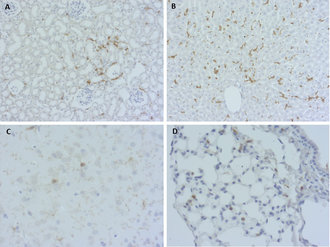
| Cat. No. HS-397 017 |
200 µl purified IgG, lyophilized. Albumin and azide were added for stabilization. For reconstitution add 200 µl H2O. Then aliquot and store at -20°C to -80°C until use. Antibodies should be stored at +4°C when still lyophilized. Do not freeze! |
| Applications | |
| Clone | 167B3 |
| Subtype | IgG2a (κ light chain) |
| Immunogen | Synthetic peptide corresponding to AA 28 to 42 from mouse F4/80 (UniProt Id: Q61549) |
| Reactivity |
Reacts with: mouse (Q61549). No signal: rat. Other species not tested yet. |
| Remarks |
IHC-Fr: The following fixatives are possible: methanol, 4% formaldehyde/PFA. |
| Data sheet | hs-397_017.pdf |

F4/80 positive cells in murine FFPE tissues